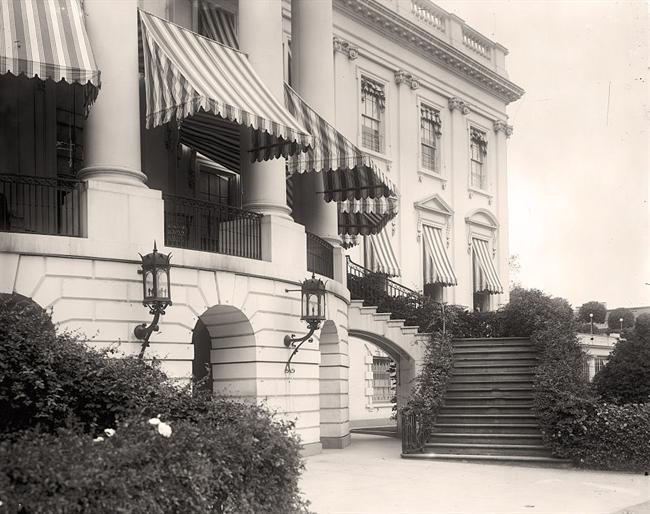
In the days before air-conditioning, the South Portico of the White House with the ubiquitous striped awnings that shaded the Blue Room portico from the capital’s famously beastly summer heat but collected dirt fast. Although the portico was on the public state floor, it was the only place the presidential families could sit outside in the shade. It would be another thirty years before there was air-conditioning installed and a balcony above it, leading out from the private family quarters.
From the perspective of 2017, a hundred years ago seems might as well be the medieval age.
Technology, globalization, medical science, really everything, has so permanently changed the way we all live that there seems to be little resemblance to how we lived then. It was true for the family of the President of the United States as well as for everyone else.
And yet, nothing happens so suddenly that one can’t trace the timeline of what we’ve been conditioned to accept as “progress” and see the points of no return.
Just as the first decade and a half of the 21st century has marked a radical change in the way society interacts, so too did the first decade and a half of the 20th century. While Will and Nellie were in the White House, more homes were outfitted with electricity than ever before, and began keeping in touch by telephone, rather than by letter or telegram. The Tafts heralded the introduction of cars to the presidency. They promoted the rapid changes of “aeoroplane flight,” the President often going out to watch the Wright Brothers demonstrations in open fields in Arlington, Virginia. They didn’t have Spotify, but they got the first Victrola.
Seventy-three years earlier, still images that captured exactly what people really looked like had been introduced, Americans were first able to see in the form of daguerreotypes, on public display, and shortly after on small carte-de-visite cards the faces of legendary old Americans like Dolley Madison, Andrew Jackson and John Quincy Adams. Starting with John and Julia Tyler in 1844, every single President and First Lady would be photographed and (except for one holdout) the public came to naturally expected to see what they looked like in newspapers and magazines by the end of the century. One hundred years ago, a new turning point in technology offered Americans their first, if brief, view of the President, First Lady (Woodrow Wilson and his second wife Edith) and the White House gardens in color, through a complicated chemical experiment. The same would not be done for the Hardings and Coolidges and Hoovers, but from the Franklin Rooosevelts on out, all would be seen in color.
A century ago this year, the United States had entered its first global war, “The Great War,” as World War I was known before there was a World War II. By President Woodrow Wilson’s declaration in April of 1917, Americans first sent their sons to join England, France and Italy in fighting Germany.
It was not the precise start of globalization but it was a big turning point from which there would be no turning back. His successor Warren Harding won on the slogan of “America First,” but it was not a promise that could be practically kept. There was no turning back.
So, looking at that point in time offers perspective on how far away we now are, not just by the calendar years but by the way we now perceive life at the White House. While there had always been threats to the well-being of the commander-in-chief, even during the first world war, security for his protection seems naively lax. Taft and Wilson still went about town with relative ease and nothing at all like the phalanx of guns and metal there is now.
The “people’s house” was, as always, first and foremost, a private home for the presidential family. The rooms of the family quarters on the second floor under Taft and Wilson were far more airy and spare, a result of the fact that the West Wing had been built under the previous administration; finally the executive offices of aides that had grown to cramp the east end of the second floor were removed. There was more room for the family to live. In an era of massive immigration came a reaction to affirm the nation’s colonial history, as reflected in the old-fashioned style of chairs and beds of their rooms, mixed in with gilded sofas and European elegance.
Outside, the South Lawn was used more for large public events like concerts and garden parties than it was for presidential ceremonies. Nellie Taft’s predecessor had created a “colonial garden” but her successor, Ellen Wilson had it replaced with a finely manicured Rose Garden. Although remnants of the Wilson Rose Garden lasted for a half-century, the placement of it in the space between the West Wing and Residence remains.
Ellen Wilson died just a year and five months into her tenure as First Lady, dying right before the European war had first broken out in August of 1914. President Wilson’s second wife, Edith, had work continued on the Rose Garden to completion, but her primary role was as presidential aide. Even before the war broke out, she was always with him, even at ballgames which she didn’t particularly enjoy.
It was just about a century ago, however, with World War I that public access to the White House began in earnest. The house was no longer casually guarded. The tall black iron gates were closed. The annual Easter Egg Roll was cancelled, not to be revived until four years later and then only for twenty years before World War II and White House renovations had it discontinued for another full decade.
Perhaps living in the presidential home would have gotten back to the way it was had President Wilson not suffered a debilitating stroke at the end of 1919, but the decision to lie to the public about his true medical condition meant an even tighter restriction on access to the house.
Everyone had fooled themselves into thinking that once the war was over, life would return to the way it was, to “normal.” But, of course, it never does. There is always just a “new normal” and eventually everyone must just accept it.
Even in the old White House.
Those taking these public domain images for use on Pinterest, please credit the website carlanthonyonline.com. The hours of research effort are enormous and while made to share, it is discouraging to see one’s work used without credit. Thank you.


The Tafts return to the White House after his inaugural ceremony, Nellie Taft being the first First Lady to ride beside her husband – in her last drive as First Lady in a horse and carriage. She was all about the latest and cutting-edge. She wanted cars. She got them.

Mrs. Taft entering one of her new “motor” cars.
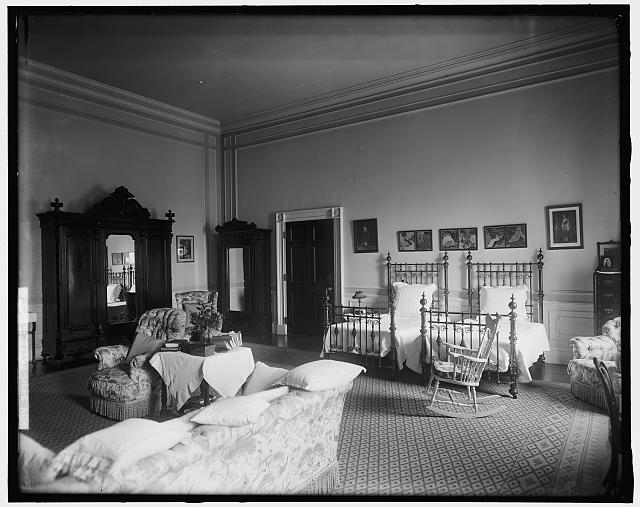
The first White House bedroom first briefly occupied by the Tafts.
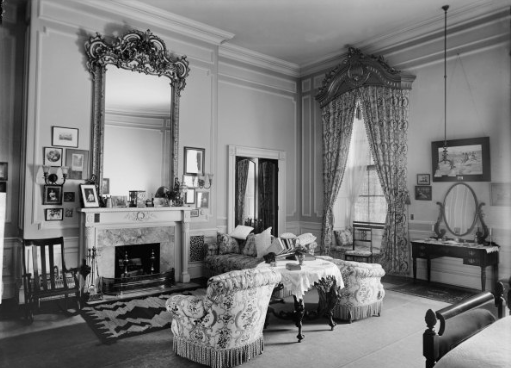
The permanent bedroom of the Tafts during their White House residency.
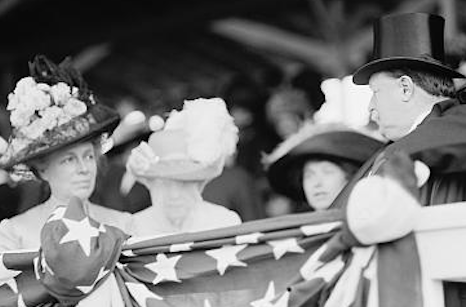
Nellie Taft loved baseball games and public ceremonies, seen here exchanging a glance at her husband.
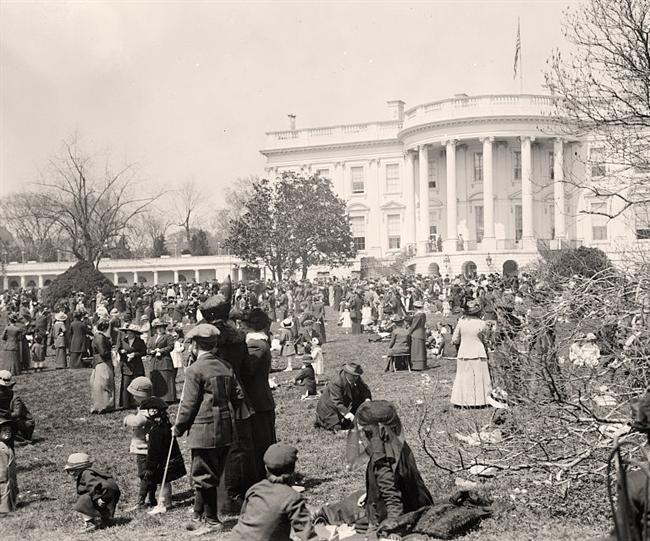
The 1912 Taft Easter Egg Roll on the South Lawn.
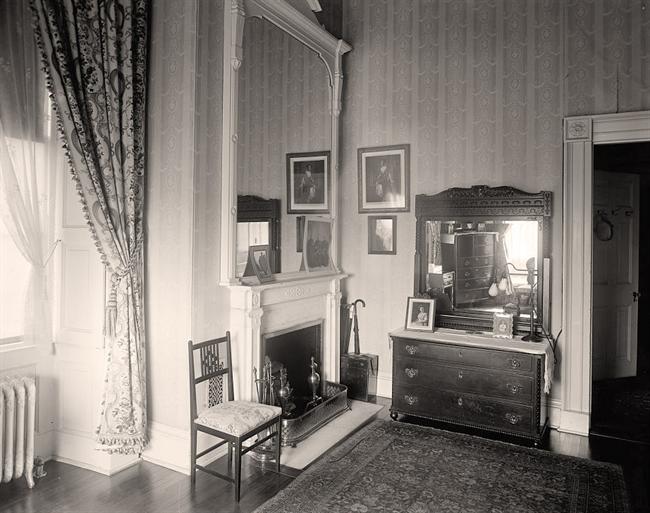
A corner of the President’s dressing room, when Will and Nellie Taft shared the bedroom that would be, for so long, designated as the “First Lady’s Bedroom” starting in 1929 with the Hoovers. The framed picture on his dresser is of daughter Helene.
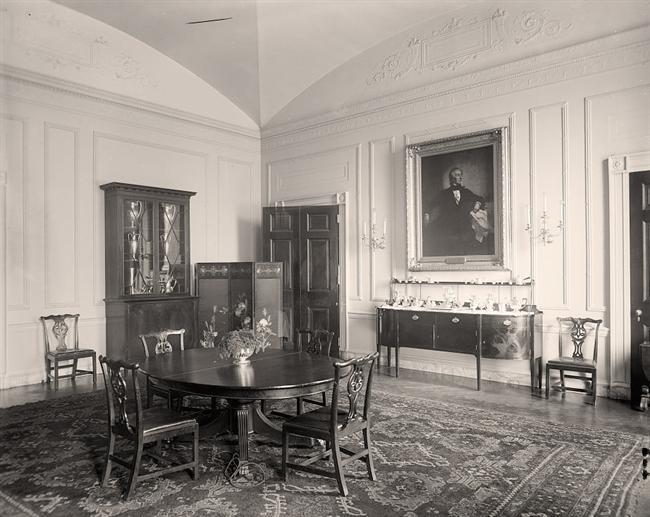
Before the Kennedy changes, the “Family Dining Room” was located on the state floor, rather than in the family quarters. The First Families would have to come downstairs to formally eat together.
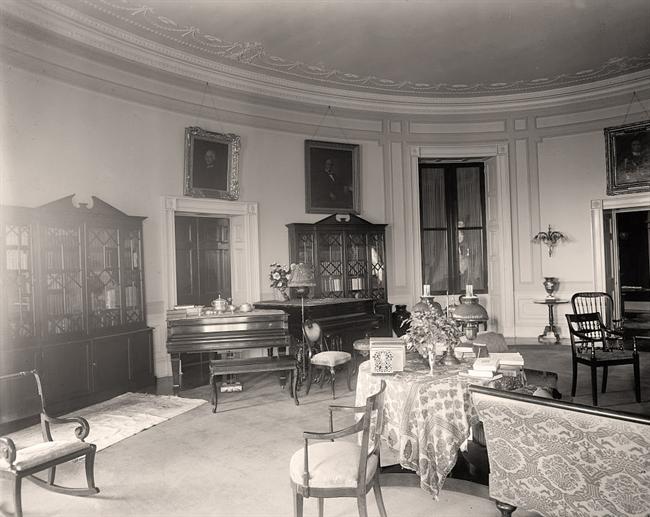
The old-fashioned looking Taft Oval Room; later furnished in yellow by the Kennedys it has remained that color scheme ever since.

A corner of the Blue Room under Taft; they were the first to put a Victrola here, that time’s latest technology that provided music.

The Taft victrola record player in the Blue Room.

As always, the South Lawn was a good old American lawn – it has always fought the losing battle of crabgrass.

A guest bedroom in the family quarters under the Tafts, remaining unchanged under the Wilsons.
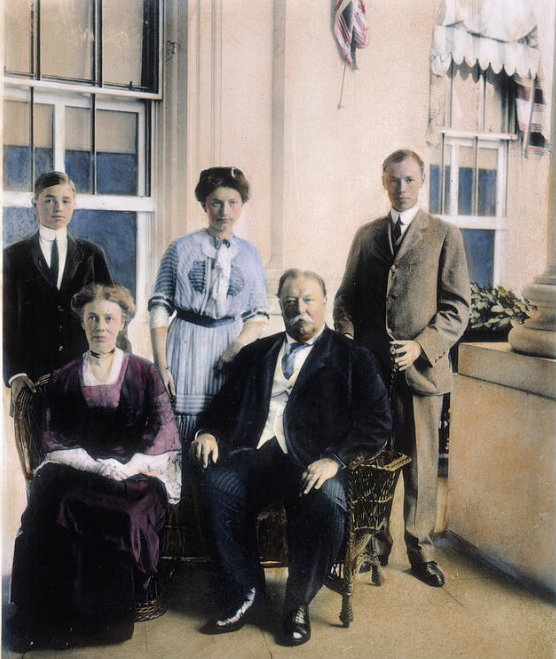
Colorized in later years, Will and Nellie Taft, with their kids Charlie, Helene and Bob, marking their silver wedding anniversary in June of 1911.
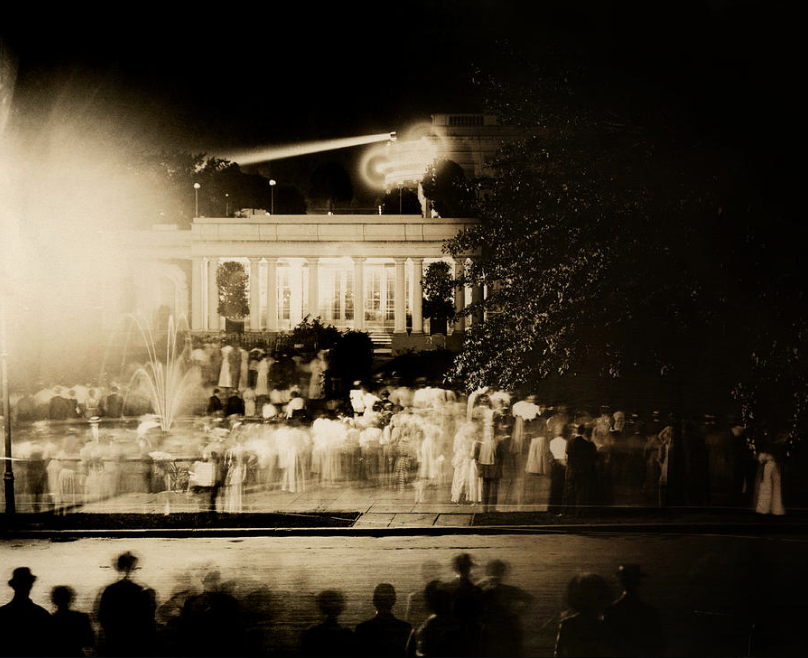
Nellie Taft had the entire White House illuminated for the first time in the modern wonder of electricity during the night of her mammoth silver wedding anniversary party, drawing thousands of curious onlookers outside the gates. She decided to keep the decorations in place and haul out the leftovers, opening the mansion and grounds to the public the next night so they could enjoy what her party guests had the previous evening.
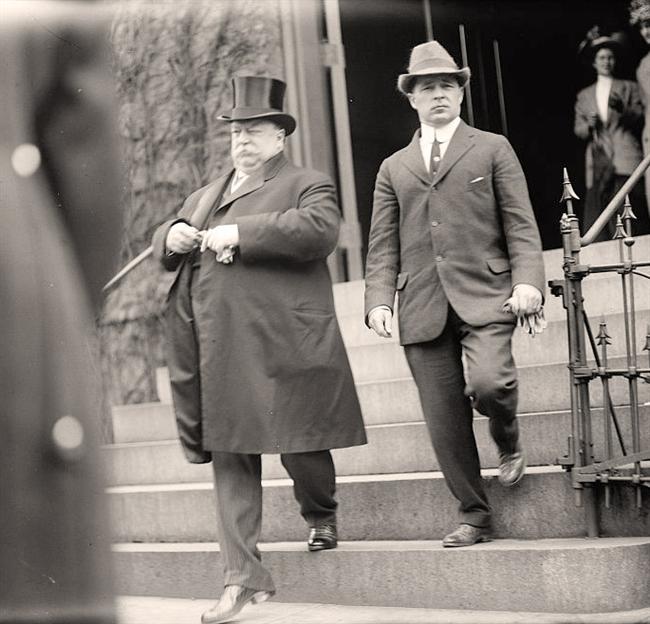
President Taft leaving church.

President Taft in the new, first Oval Office.
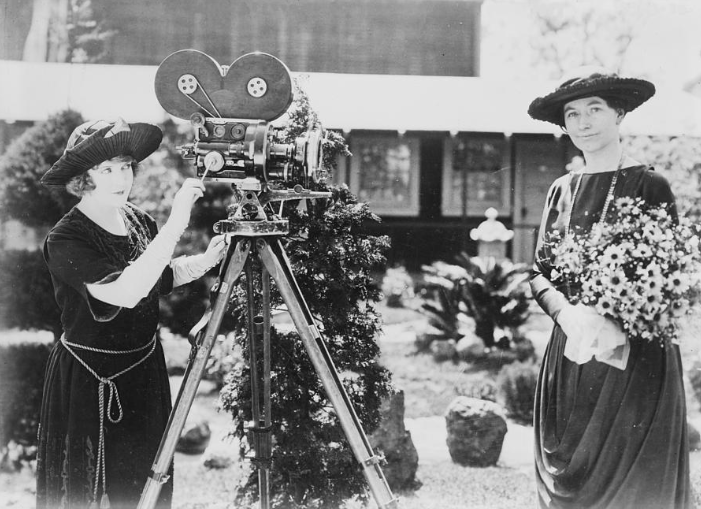
Helene Taft posing while a friend tries her hand cranking a moving picture camera..
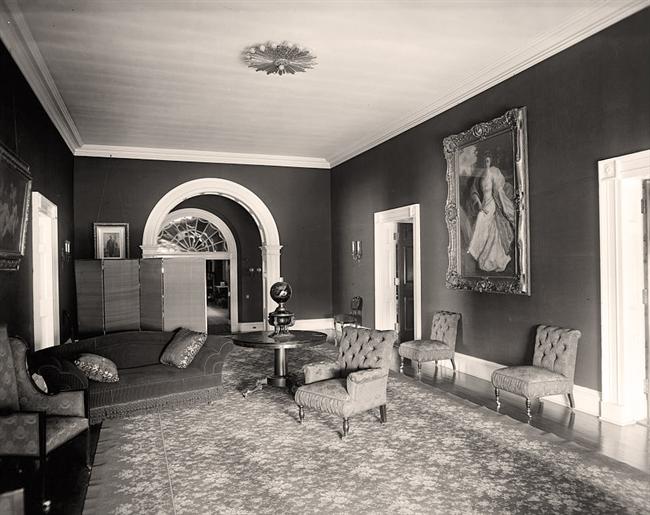
The West Sitting Hall of the Taft White House, where Nellie’s larger-than-life portrait was hung.

President Taft posing on the South Portico with leaders of national Jewish organizations.
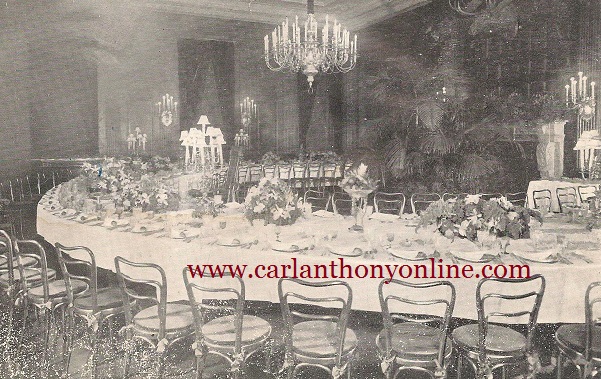
Nellie Taft’s crescent-shaped table set for a diplomatic dinner in the State Dining Room.
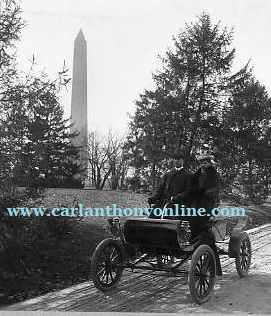
Miss Helene Taft being “motored” for an excursion, leaving the house.
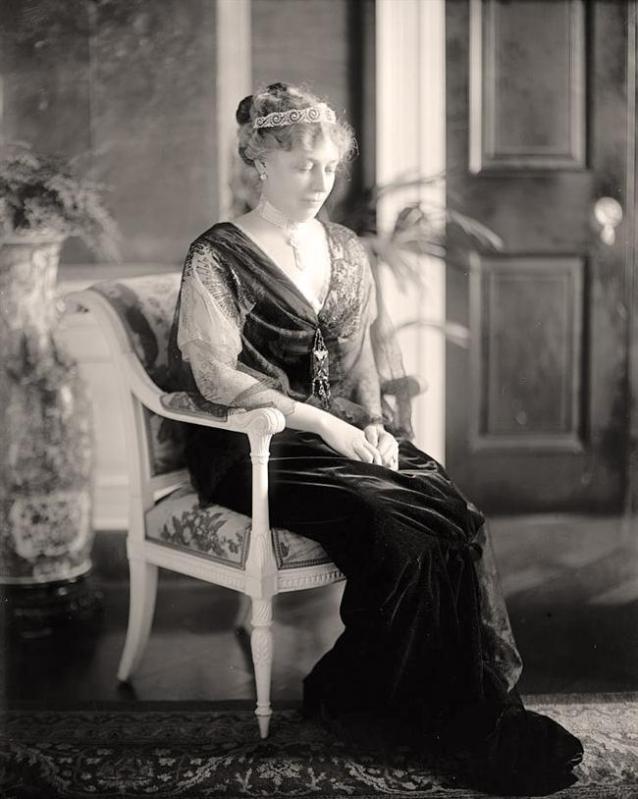
Nellie Taft posed in the Red Room.
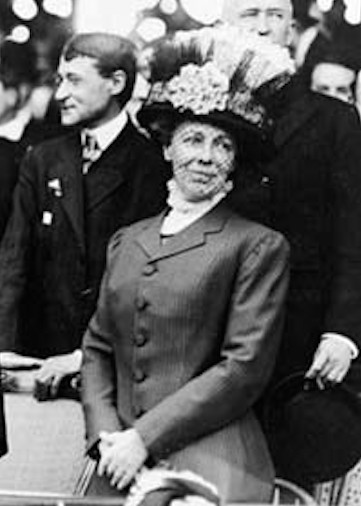
A winsome Nellie Taft at opening day of the Senators game, 1911.
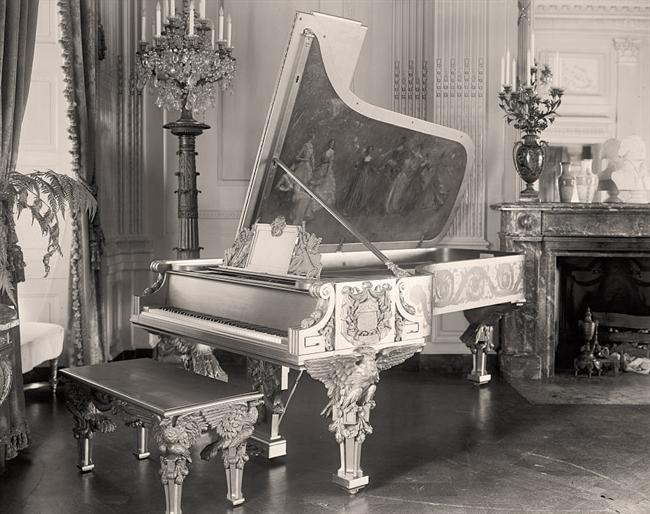
The grandiose and gilded piano in a corner of the East Room; a founder of the Cincinnati Symphony Orchestra, Mrs. Taft instituted a series of high-quality musicales.

President Taft enjoyed shopping out among the people, without any Secret Service protection.

Taft, posed in the Oval Office,
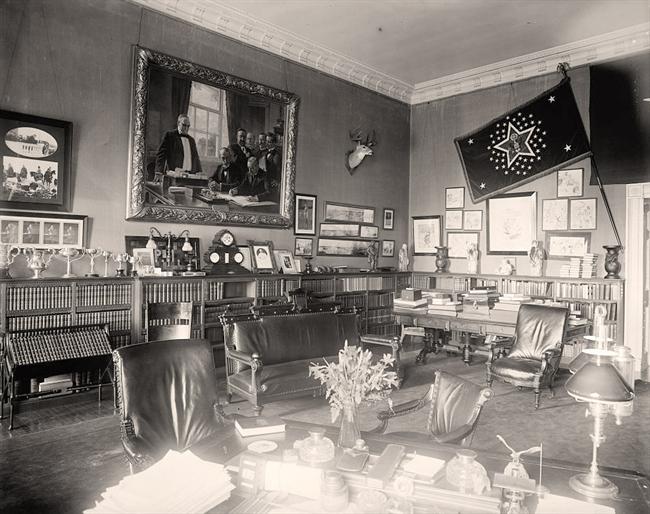
The private study of Taft had previously served as the Cabinet Room, where McKinley conducted the Spanish-American War; the large painting captured him during a treaty signing in the room.
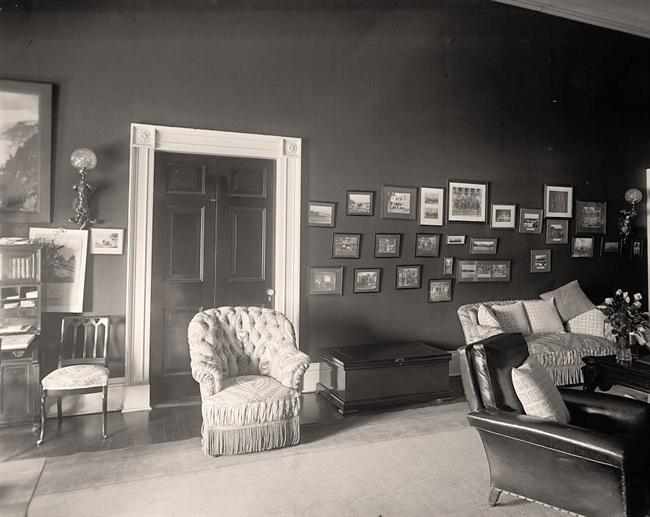
Nellie Taft had the walls of the center hall of the old White House covered in a forest green paper, and lined with small framed pictures, like a gallery.
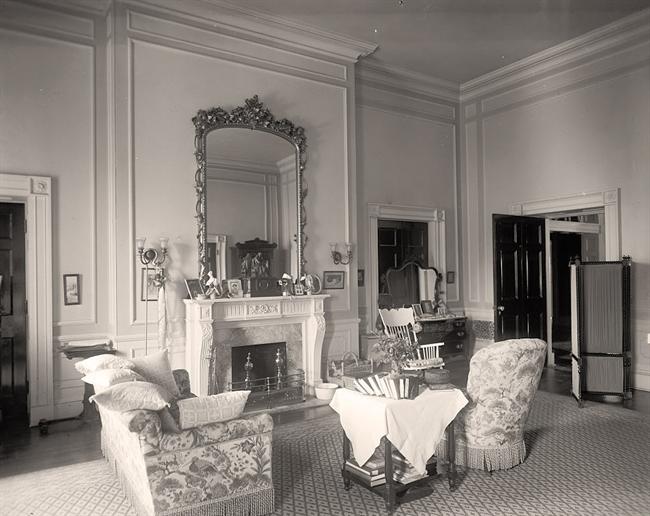
The Tafts’ bedroom suite sitting area, a lot less busy than it initially looked, many framed pictures and gewgaws removed.

Idling on West Potomac Drive, seated in one of several new “motors” she ordered for the White House, Nellie Taft makes nice with a friend and an aide.
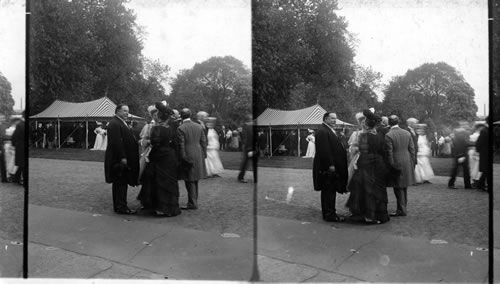
President Taft speaks with guests at a South Lawn garden party on a chilly spring day.
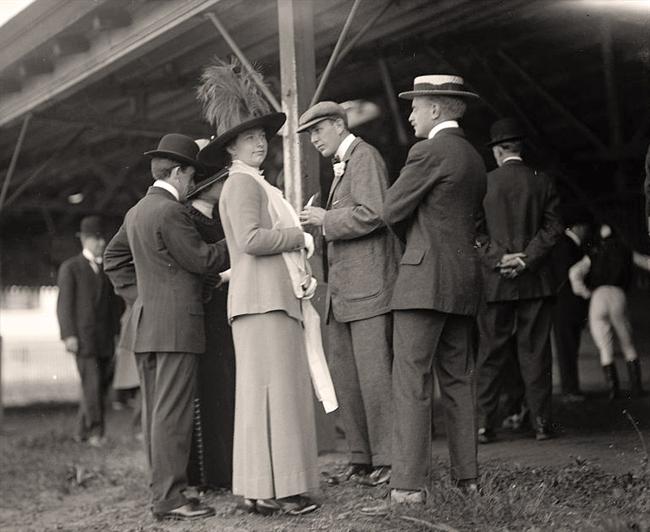
First Daughter Miss Helene Taft, at a nearby horse track. She had no security shadowing her.
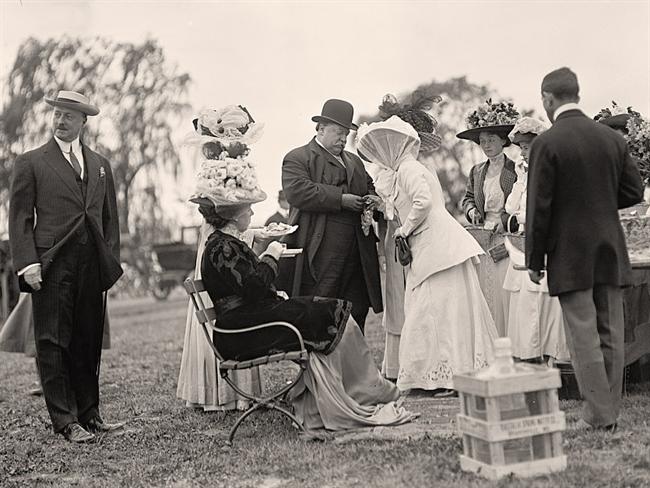
Nellie Taft, seated, having her cake and eating it too. Will stands engaging with lawn party guests on a chilly day, a big glass water container informally plopped near them. Their daughter Helen stands, in large black hat, third from the right.
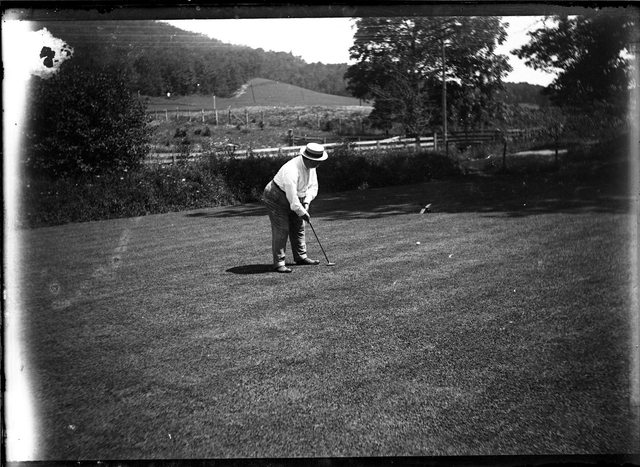
President Taft on his beloved golf course, the first to make it a habit. Note the penned farm animals in the background.

Taft turns over the presidency to Woodrow Wilson, Inauguration Day 1913.
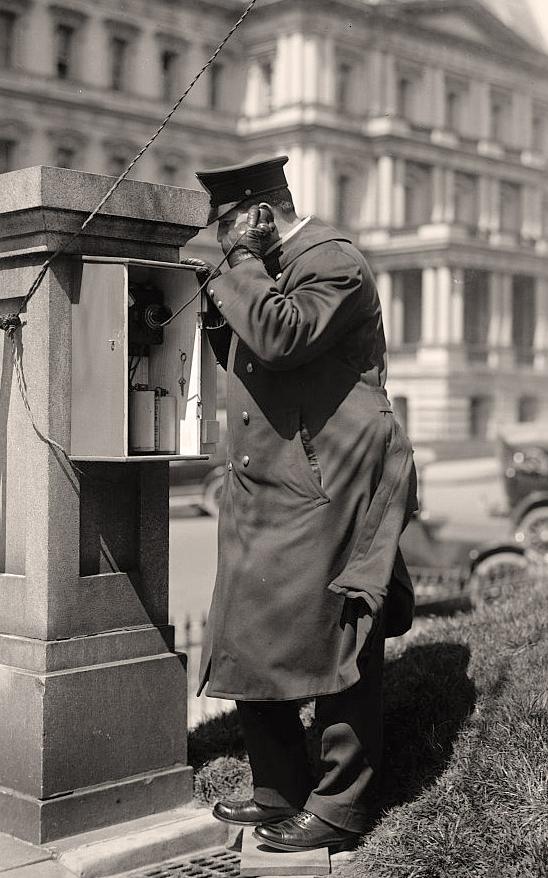
A White House police guard on a phone. There was still very little security during the war – but the public was no longer given easy access to it.
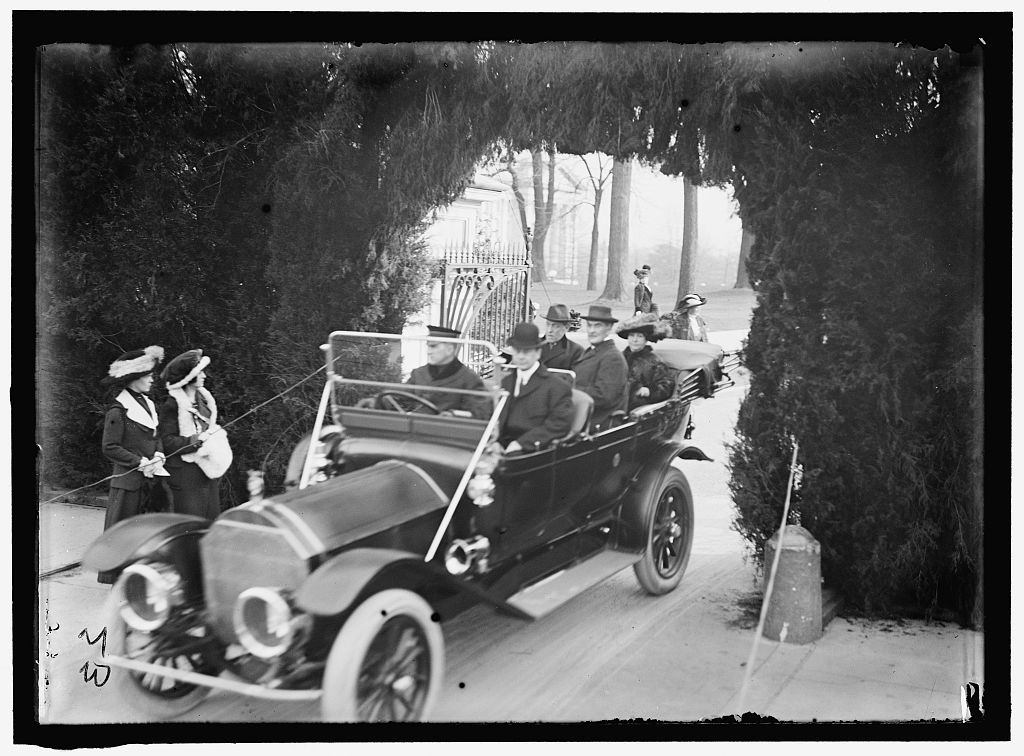
Woodrow and Ellen Wilson leaving the White House for a drive.
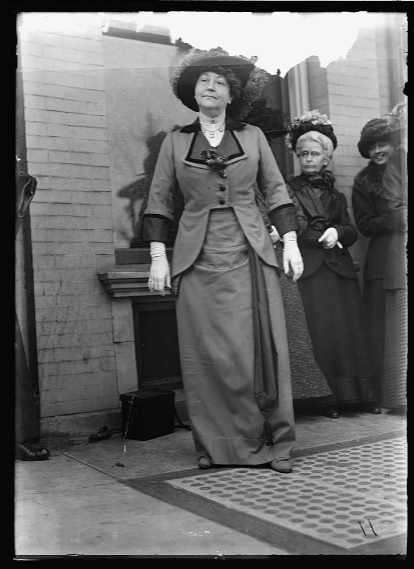
Ellen Wilson, pleased after an inaugural luncheon.
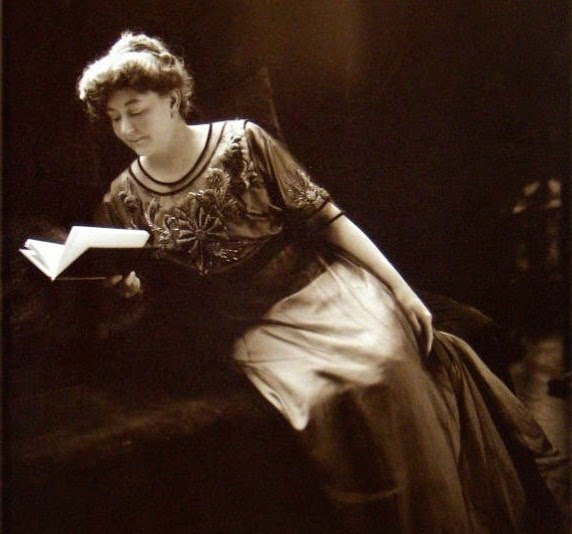
Highly literate and political, artist Ellen Wilson reviewed and edited her husband’s speeches.
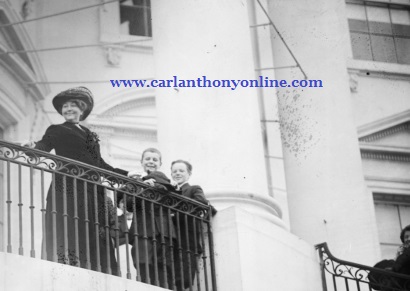
First Lady Ellen Wilson takes in the 1913 Easter Egg Roll from the South Balcony.
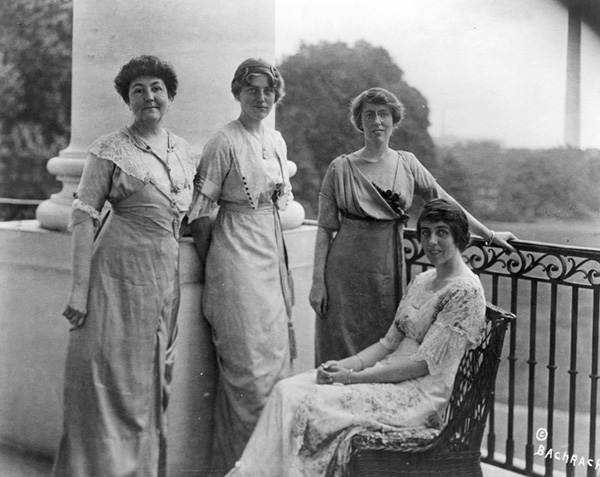
Ellen Wilson and her three daughters on the South Portico (LIbrary of Congress)
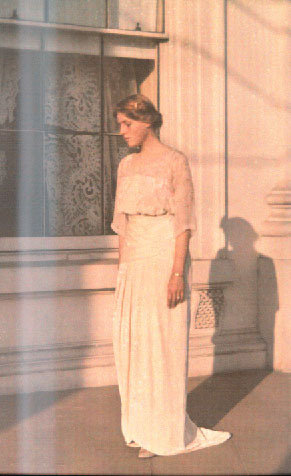
A rare color image of First Daughter Jessie Wilson on the South Portico.

Nell Wilson, posed in the White House.
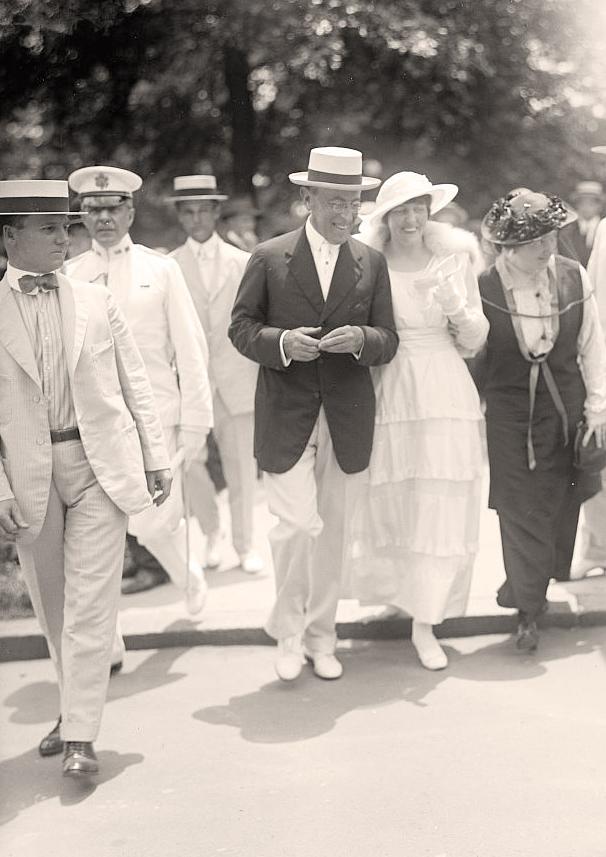
Wilson strolling the grounds with his daughter Nell.
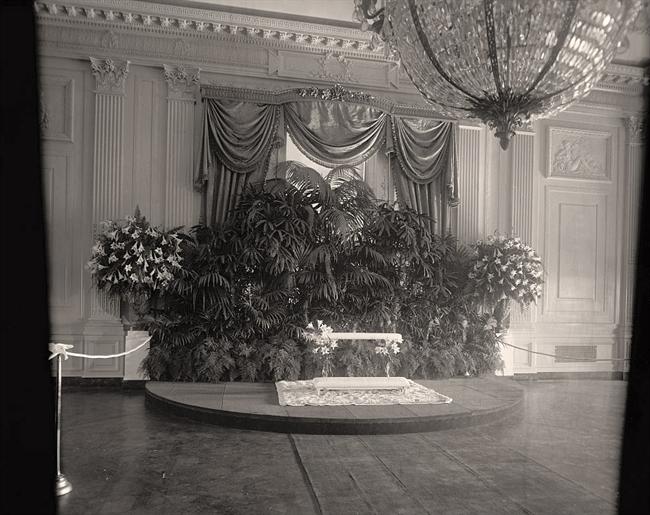
The wedding altar in the East Room where Jessie Wilson married Frank Sayre in 1914.

The Wilson-Sayre wedding party posed in the West Sitting Hall of the White House.
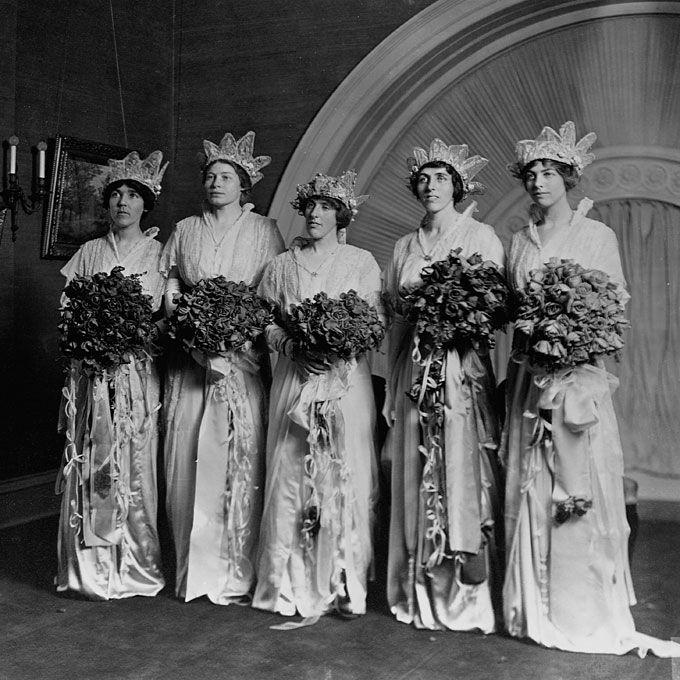
Jessie Wilson’s bridesmaids included her sisters Margaret (center) and Nell (second to left).
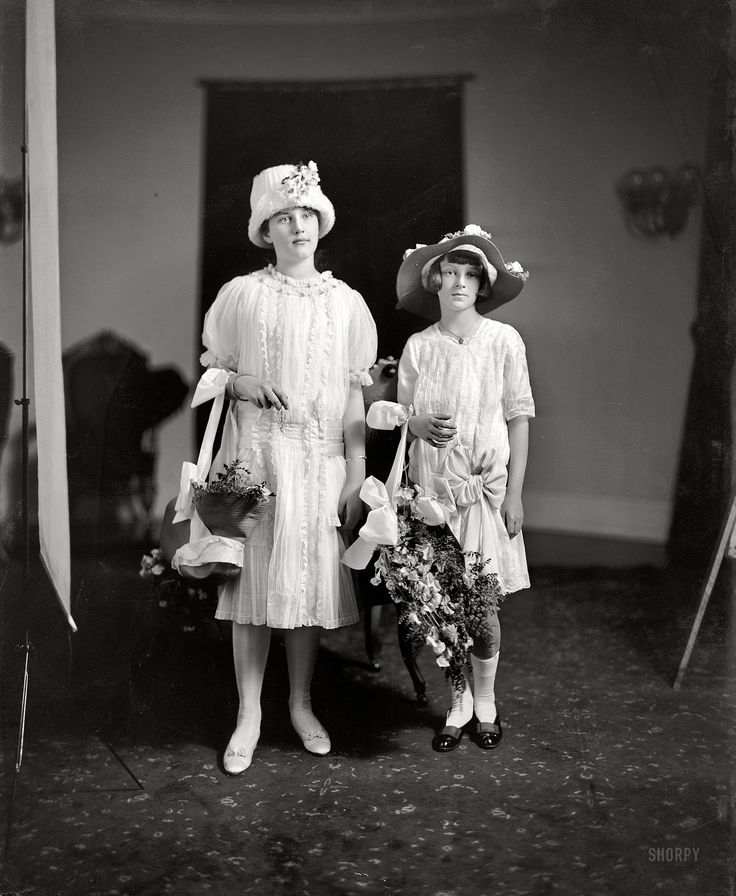
Flower girls at Nell Wilson’s White House wedding.

Newspaper report of the first Mrs. Wilson’s imminent death and how her three daughters were at her side when she died.
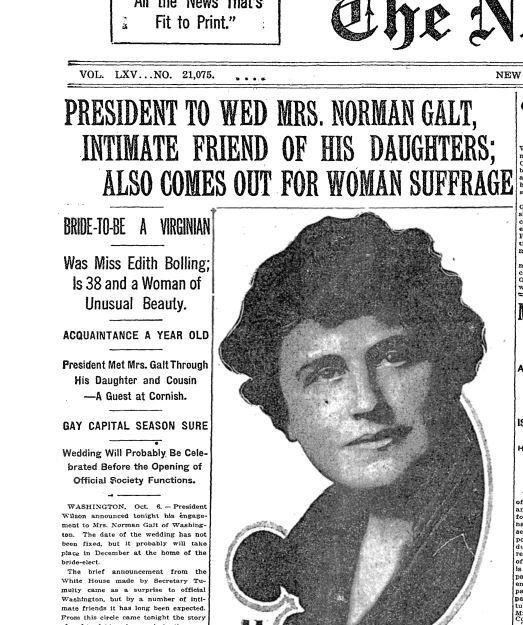
Newspaper announcement of the widowed President’s remarriage.

The President’s fiancé adored him but many others found her vain, arrogant, ignorant and bigoted.
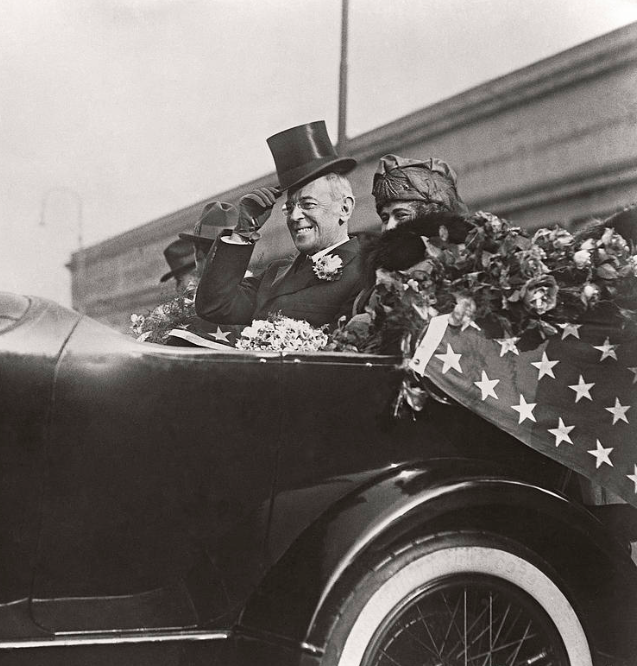
The Wilsons in their open car.
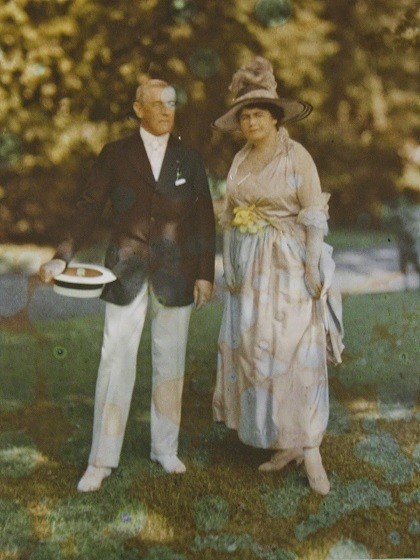
Rare color image of Wilson and his new wife.
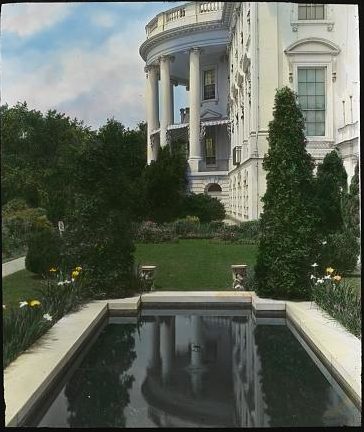
Color image of the East Garden of the White House.

Edith Bolling, the President’s finance and her mother riding with him to the White House.
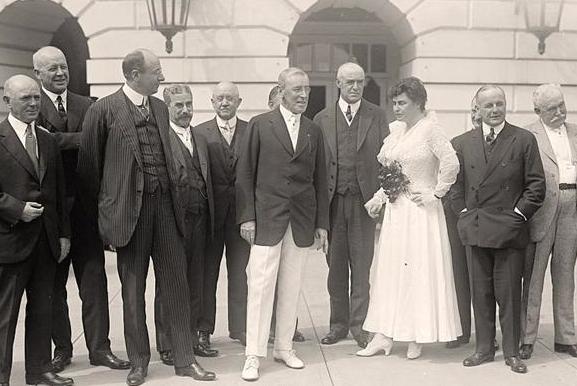
Woodrow Wilson and his second wife pose with National Democratic Party leaders.

Seen here at the east White House garden lilly pond, President Wilson and his second wife Edith Bolling Galt in one of several rare color plates made in 1915.
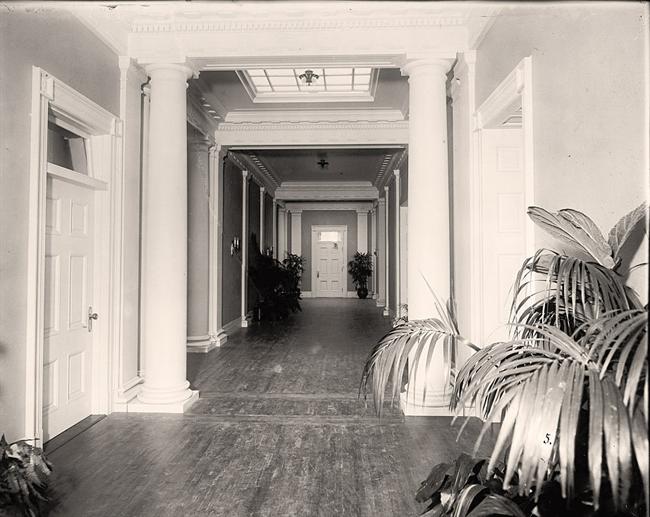
Long corridor in the old White House.
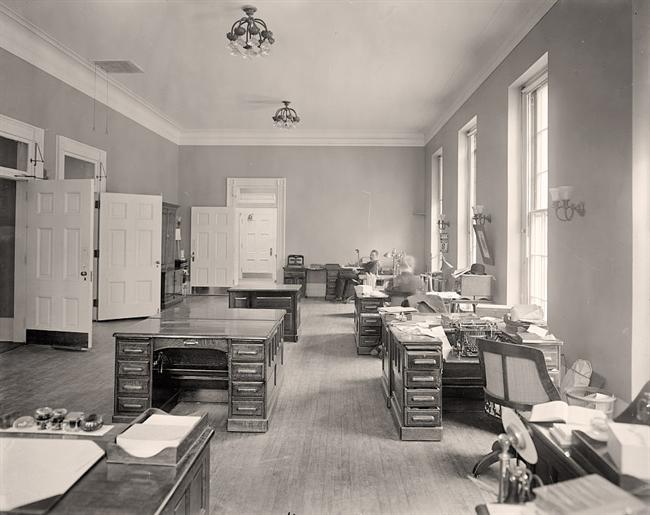
The new executive offices of the West Wing.
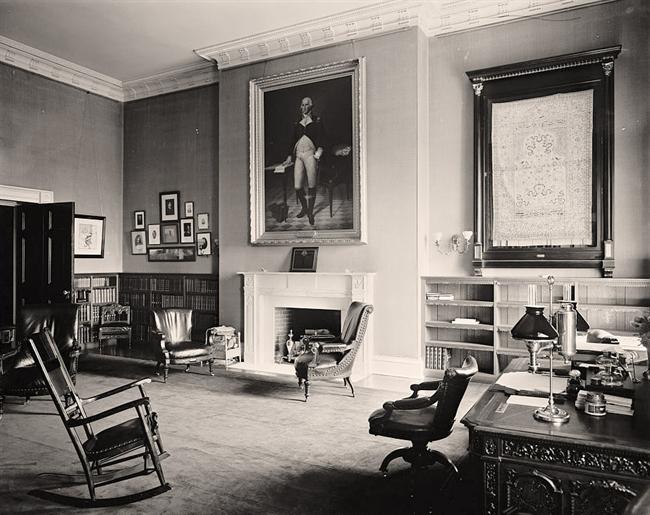
The President’s private library and office under Wilson.
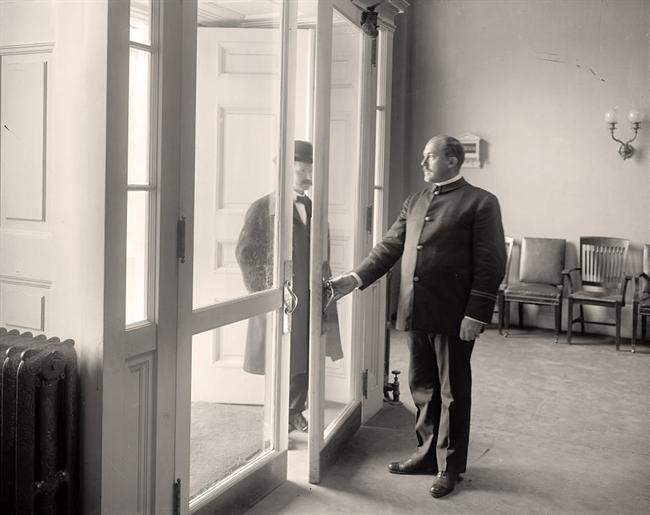
The entrance to the new executive offices of the West Wing.
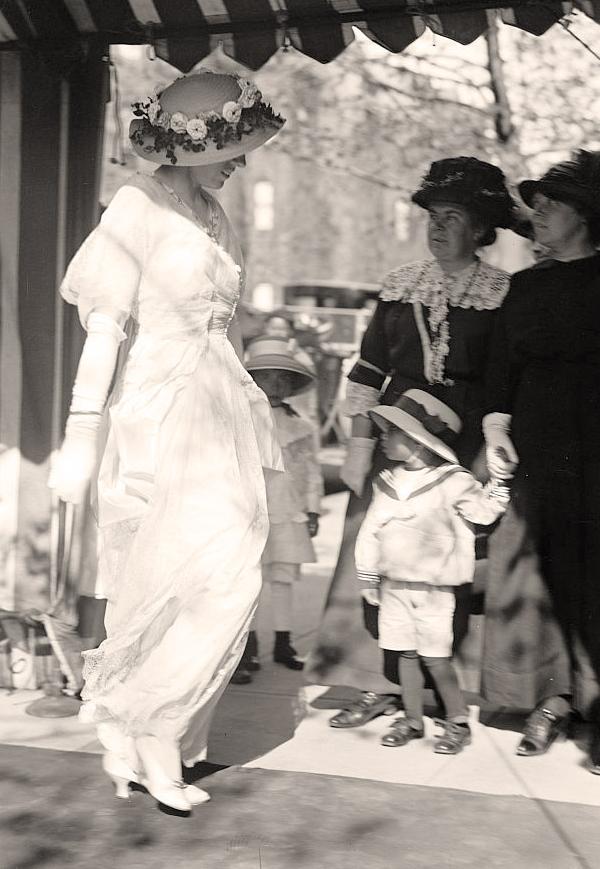
Nell Wilson leaving a local luncheon.
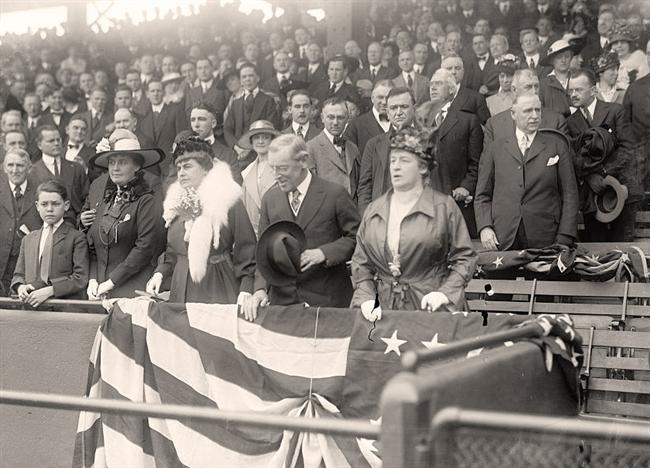
Edith Wilson, in white fur, scowls during a baseball game she attended with the President.

Taft’s “Private Secretary” (akin to today’s “Chief of Staff” role) and his aide in the new West Wing office space just outside the President’s office.
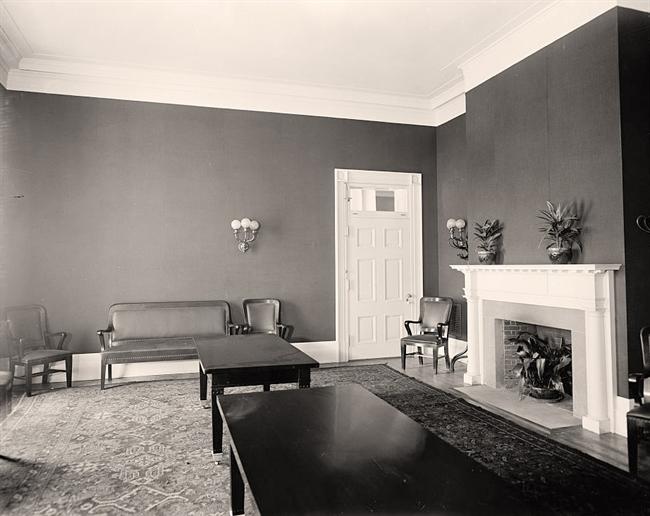
One of the new, spare West Wing reception waiting rooms.
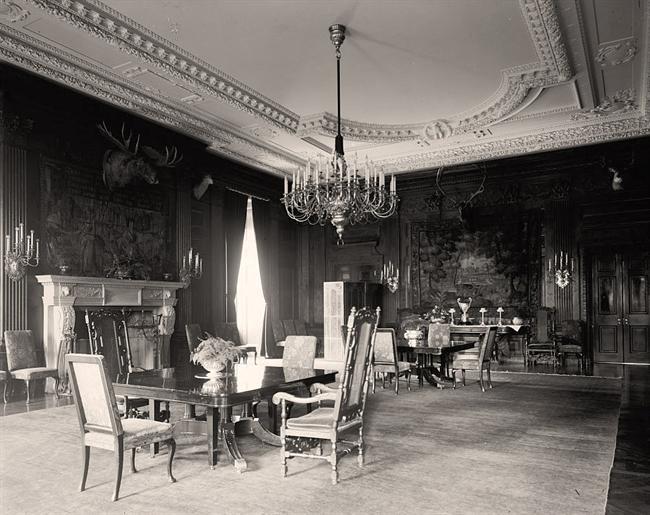
The large, formal State Dinging Room of the White House; note the moose head above the mantel, placed there by big-game hunter president Teddy Roosevelt.
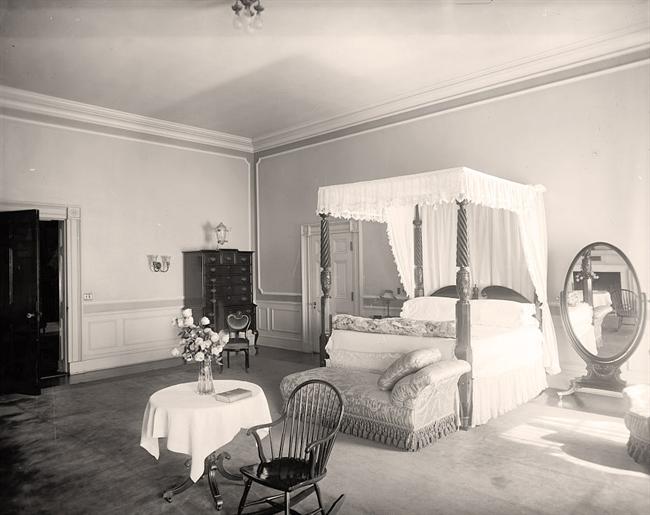
A big, comfy colonial bed in what is now the private dining room of the First Families.
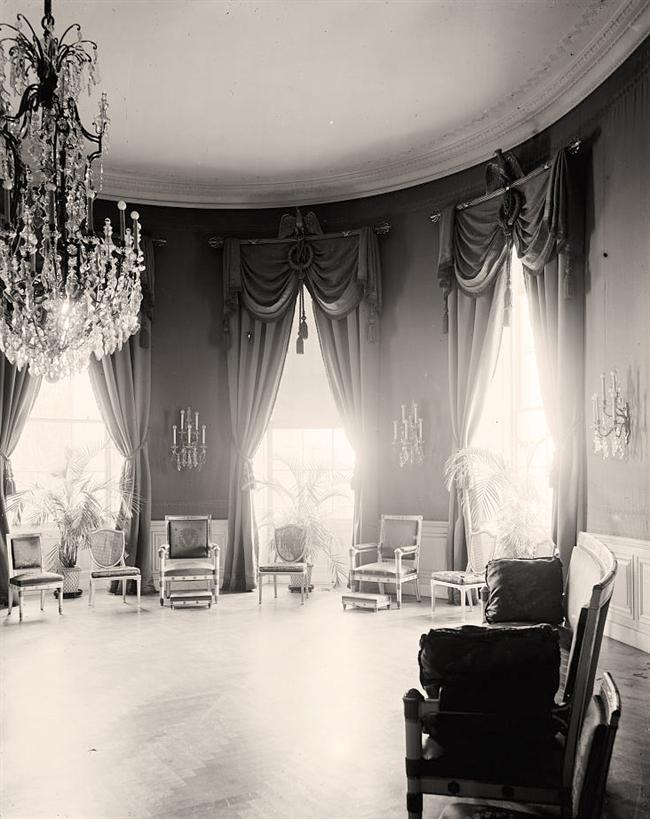
Another view of the Taft-Wilson Blue Room.
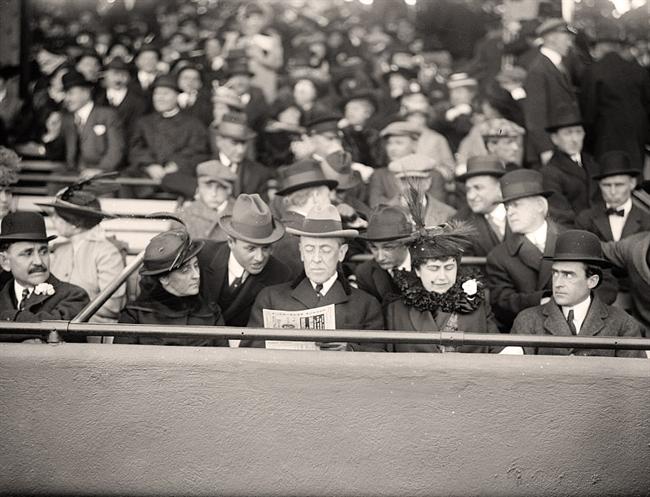
Woodrow and Edith Wilson at another ballgame.
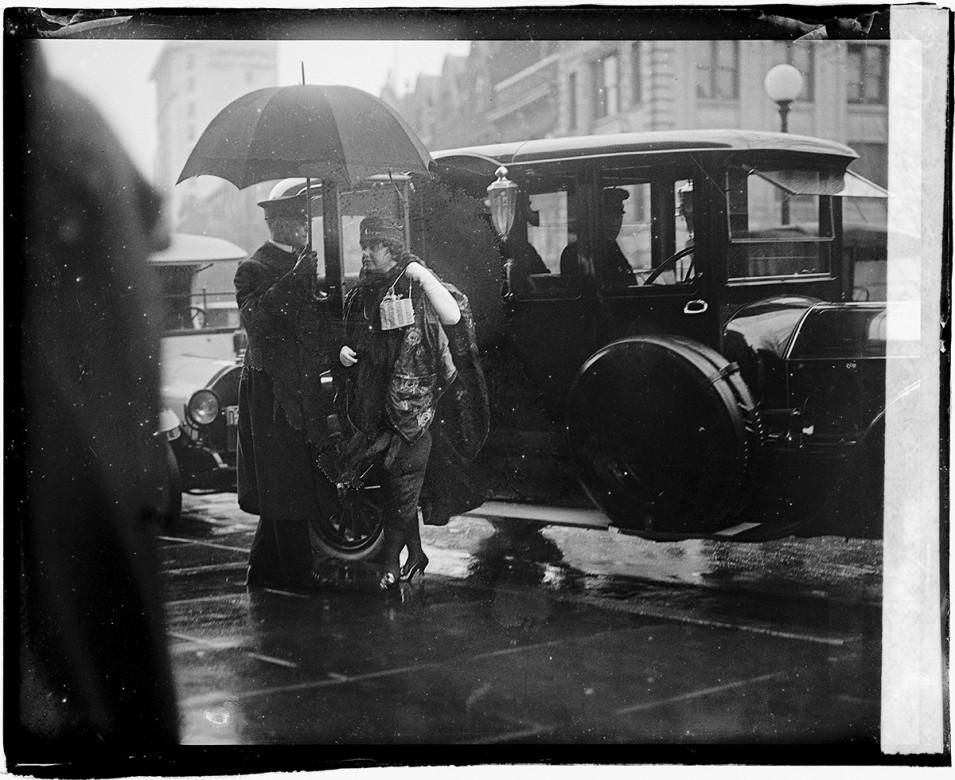
In Washington, elegant Edith Wilson out shopping in the rain.

In the Green Room, the President’s daughter and son-in-law, Frank Sayre and Jessie Wilson with their child, the first grandchild of President Wilson.
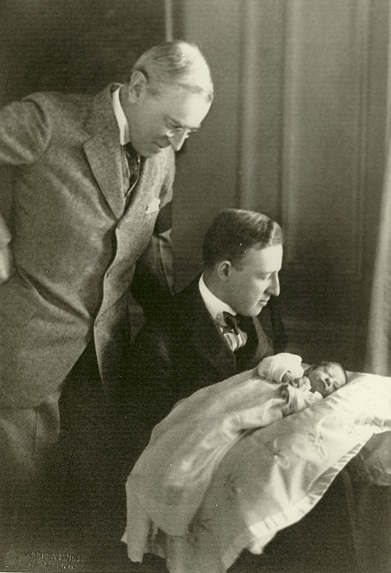
Woodrow Wilson with his son-in-law and grandson Francis B. Sayre, Jr. in the White House.

Margaret Wilson, far left, in her Red Cross uniform, worked so tirelessly for the war effort she ruined her health and singing voice. She commuted between her own Greenwich Village apartment in New York and the White House after her father remarried. She had served as First Lady in the period following her mother’s death and before her stepmother took over.
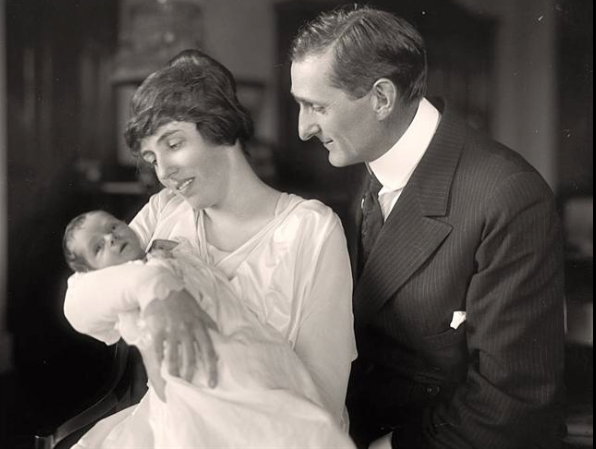
Nell Wilson, who married her father’s divorced Treasury Secretary William McAdoo in a second presidential wedding for the family, pose with their first child, the second Wilson grandchild, in the White House.
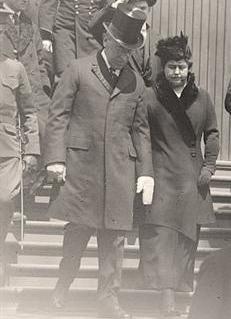
Woodrow and Edith Wilson leaving church.
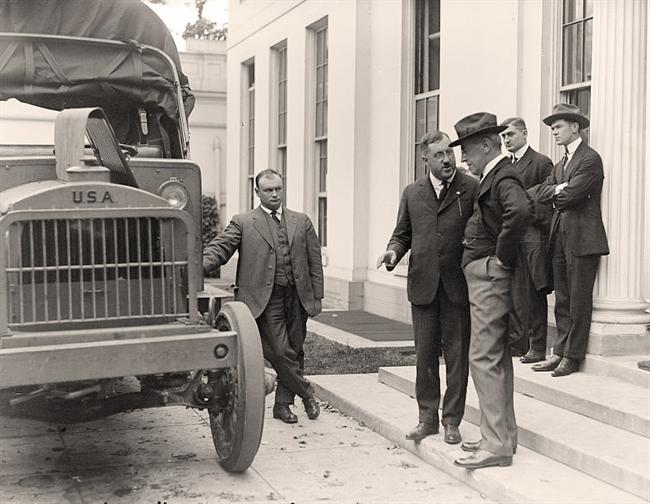
Looking over a truck to be put into war service, President Wilson steps outside of the West Wing.

From a grandstand outside the White House North Lawn, President Wilson reviews troops, 1917.
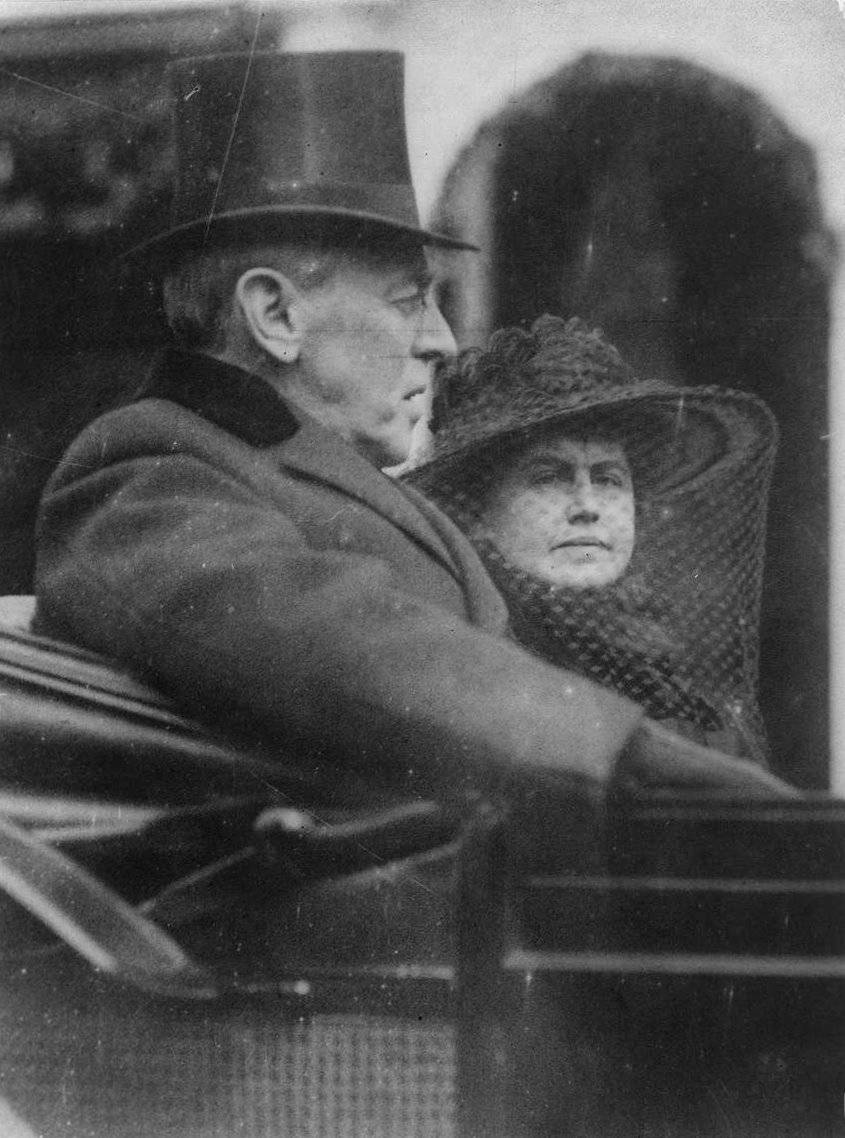
President Woodrow Wilson with Edith, driving to his second Inaugural in March 1917

Woodrow and Edith Wilson used the Lincoln bed in their bedroom.
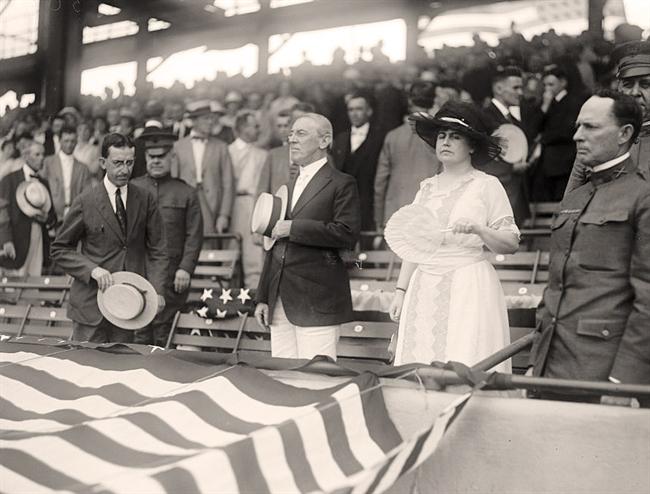
Bored but dutiful Edith Wilson accompanied the President to yet another ballgame at Griffith Stadium, and fans herself.
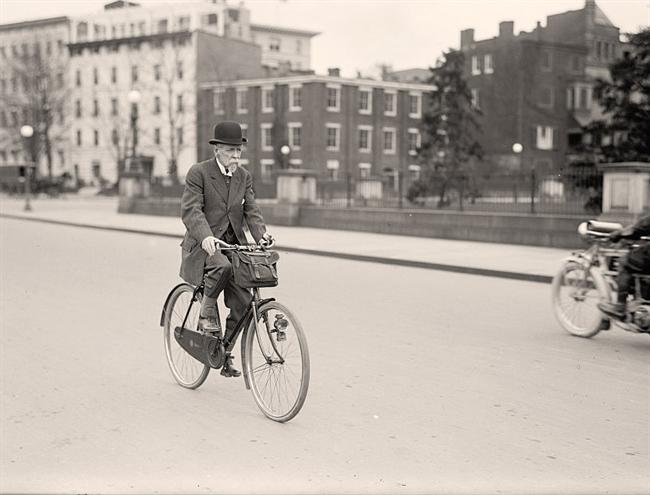
Assistant Secretary of State Augustus Alvey took no private planes to get around – he used his bike, riding past the White House.

A more pleasantly-expressioned Edith Wilson with Woodrow at yet another ballgame.
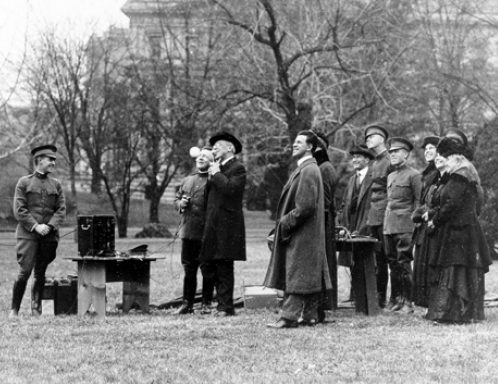
President Wilson talks with a pilot circling over the White House grounds in a demonstration of air-ground communications.
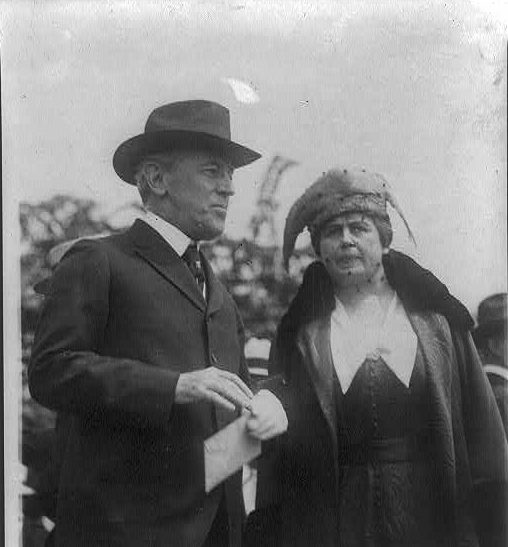
The Wilsons at a South Lawn ceremony marking the opening of the first airmail service plane.

During the war, Edith Wilson had the South Lawn populated with sheep to eat grass and thereby make the need for lawn mower manpower obsolete. The wool was sold at auction to raise money for the Red Cross.

Two lost little lambs about to become part of the White House flock of sheep that grazed the South Lawn during World War I.
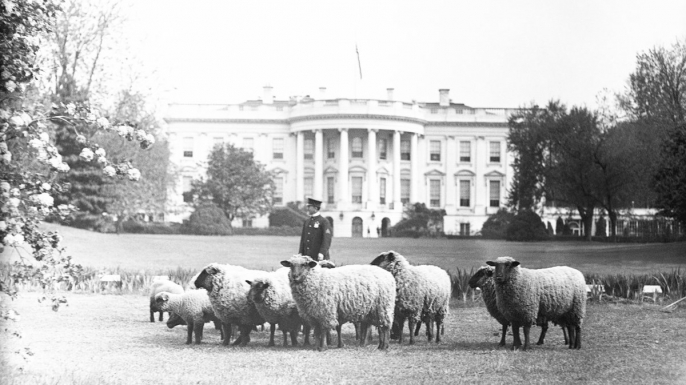
Eventually the sheep were seen fainting, traumatized by the sound of the increasing number of automobiles. Progress.
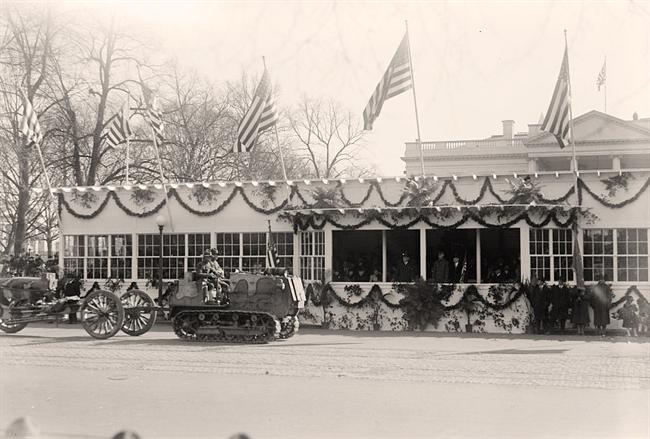
Woodrow Wilson’s 1917 inaugural parade when tanks soon to be used in the war were on display.

The President at a Senators ballgame – he left his wife at home.
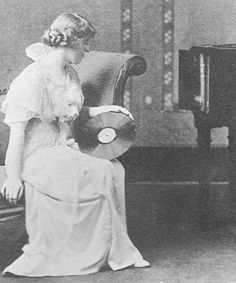
Singer Margaret Wilson poses in the Whiite House with the record album she made to raise Red Cross funds.
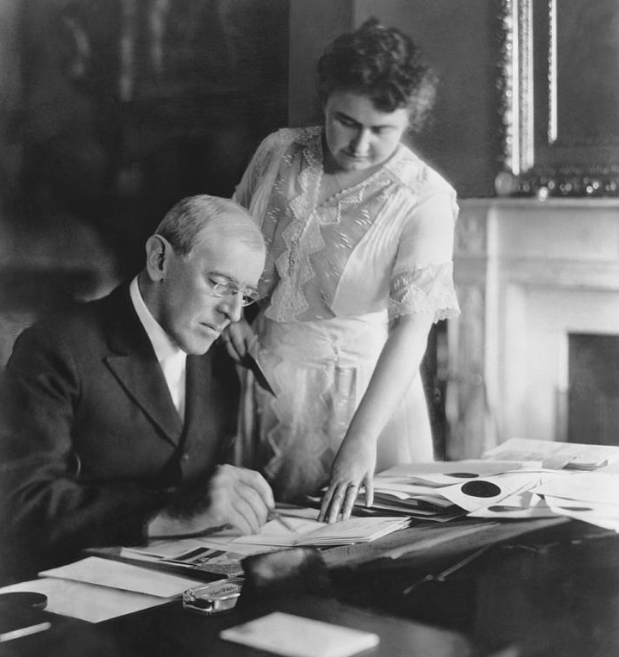
No stranger to the Oval Office or his private office, Edith Wilson worked daily as the President’s aide. After his stroke she would be accused of running the presidency.

Outside the north gates of the White House, angry suffragists demanded that President Wilson declare his support for a woman’s equal right to vote, even more sharply once the war began. Edith Wilson called them “disgusting creatures.”
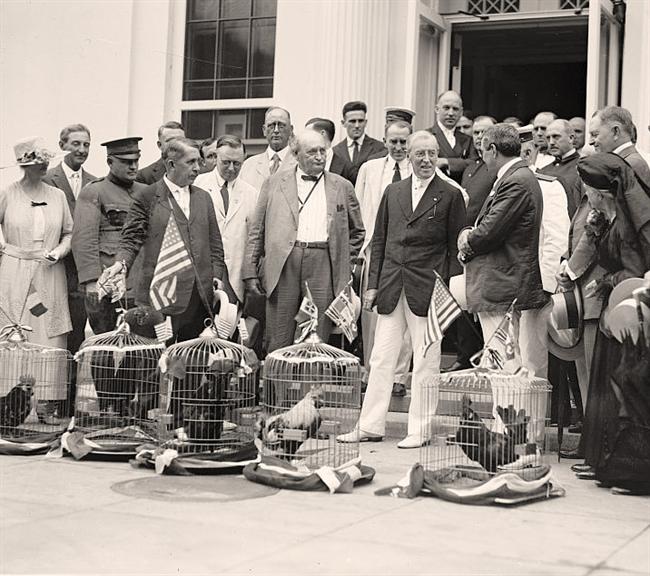
Wilson welcoming some patriotic chickens to the White House, a publicity move to encourage Americans to consume less beef during wartime food limitations.

Looks like someone wants the President to literally eat crow.

Permamently disabled both physically and mentally after his stroke, President Woodrow Wilson, with Edith and daughter Margaret.
Categories: First Families, The Tafts, The Wilsons
Tags: Edith Wilson, Ellen Wilson, Helen Taft, Nellie Taft, The White House, William Howard Taft, Woodrow Wilson, World War I
 Jackie & The Nixons: Mrs. Kennedy Returns to the White House, With New Images of the Visit
Jackie & The Nixons: Mrs. Kennedy Returns to the White House, With New Images of the Visit  The President as King: A Political Cartoon History
The President as King: A Political Cartoon History  The First White House Valentine’s Day Dance: the McKinleys, Ragtime, Racism & The Romance of the “Ghost Girls”
The First White House Valentine’s Day Dance: the McKinleys, Ragtime, Racism & The Romance of the “Ghost Girls”  Liz Taylor Meets Jackie Kennedy: Tabloid Fantasy to Chance Encounter & The Only Photos of Them Together, Part I
Liz Taylor Meets Jackie Kennedy: Tabloid Fantasy to Chance Encounter & The Only Photos of Them Together, Part I  Liz Taylor Meets Jackie Kennedy: Tabloid Fantasy to Chance Encounter & The Only Photos of Them Together, Part II
Liz Taylor Meets Jackie Kennedy: Tabloid Fantasy to Chance Encounter & The Only Photos of Them Together, Part II  Melania Trump v. John Kelly: First Ladies & West Wing Personnel, A Brief History
Melania Trump v. John Kelly: First Ladies & West Wing Personnel, A Brief History
Leave a Reply